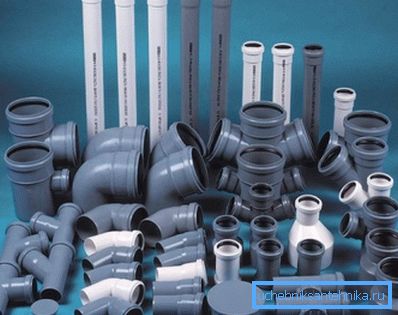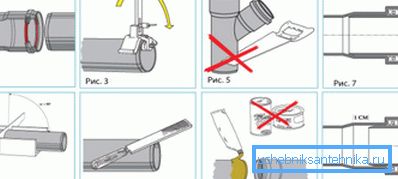Sewer polypropylene pipes: the use of an economy version for
Polypropylene pipes for sewage have a number of advantages over traditional metal products as well as other polymer varieties.
However, for the craftsmen who do the installation of sewage systems with their own hands, the most important is the ease of assembling structures. It is on this aspect that we will stop in our article.

Operational features
Benefits
If you do not plan to involve in the work of masters with professional equipment, and are going to equip the sewer system with your own hands, then it is polypropylene pipes that will be the best solution.
They are characterized by quite objective advantages, namely:

- First, the synthetic material is highly resistant to corrosion., which is very important, since the walls of the pipe are almost always in a moist state and are in contact with fairly aggressive wastewater. The chemical inertness of polypropylene results in an increase in the service life of the entire system.
- Secondly, the material has a significant heat resistance.. On the one hand, it can withstand heat up to + 95 0S: this is not so important for the sewage system, but you can be sure that hot water when it enters the sink will not cause problems. On the other hand, at low temperatures, the polymer retains its viscosity and does not become brittle.
- Thirdly, polypropylene tubes are lightweight.. Owners of light panel houses and frame structures can fully appreciate this advantage: unlike cast iron products, such a sewage network does not place increased demands on the bearing capacity of structures.

- Finally, the obvious advantage is the smooth inner surface.: The absence of irregularities provides reliable protection against blockages.
Note! This is true only if properly installed, but we will talk about precautions in the connection of pipes in the appropriate section.
- The price of such products can also be attributed to their merits.. If we take into account the ease of installation and the absence of the need to use sophisticated equipment, the financial benefit will be obvious.
disadvantages
The disadvantages of the described material are also present, however, they usually manifest themselves either as a result of defective production, or due to non-compliance with the installation rules.
Nevertheless, it is necessary to bear in mind the possible shortcomings:
- Firstly, this polymer does not have high mechanical strength. That is, it keeps the standard load satisfactorily, but if you lay the sewer pipe at a shallow depth under the road - the deformation will be solely a matter of time.
- Secondly, it is also necessary to take into account the heat resistance of plastic. Of course, deformed sewage in case of fire is not the biggest problem, but when the room is constantly working with high temperatures, or there is a risk of fire, it is better to replace polypropylene with metal.

- Thirdly, according to GOST, polypropylene sewer pipes must be manufactured with fittings fitted with rubber sealing rings (GOST 9833-73). These parts require increased attention because they lose their elasticity over time, and the tightness of the joints decreases.
- Another important feature is the tendency of the polymer to thermal distortion. That is why pipe joints are made relatively mobile: this is how internal stresses are compensated.

Many experts also note the need for careful preparation of all parts for installation. However, everything is known in comparison, and from this point of view, polypropylene can be safely attributed to the group of the most “friendly” materials to the newcomer.
Installation Features
Pipe connection
The very instructions for assembling the sewer pipeline is quite simple. It is important to remember here that our goal is to form the smoothest inner surface, and act accordingly.

In most cases, the assembly is performed by installing the nozzle into the shaped part with fixation by an elastic ring.
The sequence of operations should be as follows:
- First, we process the flat part of the pipe with a file or special trimming, removing the chamfer and forming a bevel on the edge of the nozzle. Any burr on the inside is a place of potential blockage, which we can extract!
Note! This should be done only for those pipes that have been cut in size. Solid products are usually manufactured with a bevel already formed, and only in rare cases do they require finishing with a file.
- Then we check the condition of the sealing ring: it must be intact and clean, without cracks and deformed sections.
- On the outer surface of the nozzle and the inner surface of the fitting we apply a thin layer of silicone grease. This will facilitate the connection of parts and provide a more reliable seal.
- We insert the nozzle into the shaped part until it stops and with a marker mark the line of the joint. After that, push the nozzle about 10 mm, leaving a gap for thermal deformation, which we discussed in the previous section.

Tip! At installation of fittings and short (less than 50 cm) pipes, the gap can be neglected.
System gasket
Having understood the basic principle of connecting polypropylene pipes, you can proceed to the installation of the entire system.
Here the rules are also simple:
- Inside the premises, all sections of the pipeline must be fixed to the supporting structures with pipe clamps. This will ensure the absence of loads on the connecting nodes.

- When installing in a floor or underground, horizontal sections should be placed with a slope. The optimal value of this parameter is about 15-20 mm per linear meter.
- When plastering the elements of the sewer system laid in the grooves of the sewer system, their contact with finishing materials should be minimized. To do this, each pipe is wrapped with packaging polyethylene, corrugated cardboard, mineral wool, etc.
- The point of passage of the sewer through the wall is made using a plastic or steel sleeve with a diameter larger than the outer diameter of the pipe itself. This will reduce the risk of squeezing the structure when the building collapses.
Conclusion
The technical characteristics of sewage polypropylene pipes make it possible to effectively use them for the installation of internal and external parts of the drainage system. Low cost, an extensive range of parts, as well as ease of installation make this material very attractive for beginners. And to learn the technique of connecting such pipes will help the video in this article.